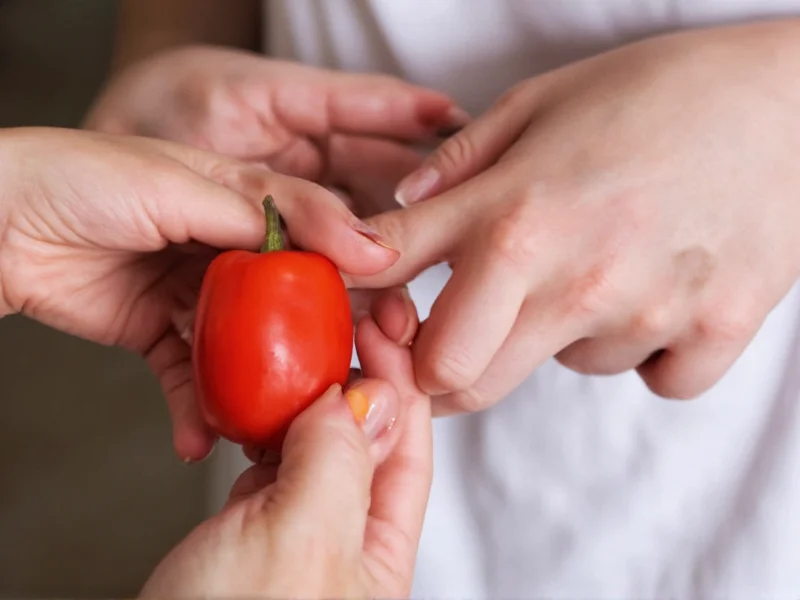Understanding Why Pepper Juice Burns and How to Remove It
When you handle hot peppers, the active compound capsaicin transfers to your skin. This oil-based substance binds to pain receptors, causing that familiar burning sensation. Many people make the mistake of reaching for water first, but since capsaicin is oil-soluble rather than water-soluble, water actually spreads the compound while providing zero relief.
The Science Behind Effective Pepper Juice Removal
Capsaicin's chemical properties explain why certain removal methods work while others don't. As a lipophilic (fat-loving) compound, capsaicin dissolves in oils and alcohols but not in water. This is why understanding how to remove capsaicin from skin requires approaches that target its chemical nature.
| Removal Method | Effectiveness | Time to Relief | Accessibility |
|---|---|---|---|
| Vegetable/Olive Oil | ★★★★☆ | 2-5 minutes | High (kitchen staple) |
| Alcohol-based sanitizer | ★★★★★ | 1-3 minutes | High (common household item) |
| Milk or yogurt | ★★★☆☆ | 3-7 minutes | Medium |
| Baking soda paste | ★★★☆☆ | 5-10 minutes | High |
| Water alone | ★☆☆☆☆ | No relief | High |
Step-by-Step Guide for How to Get Pepper Juice Off Hands
Immediate Action Protocol
- Don't touch your face or eyes—capsaicin transfer can cause severe irritation
- Apply oil first: Pour vegetable, olive, or coconut oil on affected areas and rub for 30-60 seconds
- Wipe away oil with a paper towel (don't rinse yet)
- Apply alcohol (hand sanitizer or rubbing alcohol) and rub for another 30 seconds
- Wash thoroughly with soap and warm water
- Repeat if burning sensation persists
Alternative Methods When Oil Isn't Available
If you're looking for how to stop hands burning after cutting peppers without kitchen oils, try these alternatives:
- Alcohol-based hand sanitizer: The alcohol dissolves capsaicin effectively. Apply generously and rub for 1-2 minutes before washing
- Dairy products: Soak hands in milk or apply yogurt—the casein protein helps break down capsaicin
- Baking soda paste: Mix 3 parts baking soda with 1 part water, apply to skin, and gently rub before rinsing
- Lemon or lime juice: The acidity can help neutralize capsaicin (test on small area first as citrus may irritate already-sensitive skin)
What Not to Do When Handling Pepper Burns
Avoid these common mistakes when seeking pepper burn relief methods:
- Don't use only water—it spreads the oil and intensifies the burn
- Avoid heat—hot water or heating pads increase blood flow and worsen the burning
- Don't scratch—this embeds capsaicin deeper into skin
- Never use bleach or harsh chemicals—these cause chemical burns
Preventing Pepper Burns During Food Preparation
The best approach for how to get pepper oil off hands is prevention:
- Wear nitrile gloves (latex doesn't block capsaicin)
- Apply a thin layer of cooking oil to hands before handling peppers
- Use a dedicated cutting board for spicy peppers
- Wash knives and surfaces with oil first, then soap and water
When to Seek Medical Attention
Most pepper burns resolve with home treatment, but consult a healthcare provider if:
- Burning persists for more than 24 hours despite proper treatment
- You experience blistering or skin damage
- Capsaicin gets in eyes or mucous membranes
- You have an allergic reaction (hives, swelling, difficulty breathing)
Long-Term Protection Strategies for Frequent Pepper Handlers
For chefs or frequent cooks working with hot peppers, consider these professional effective home remedies for pepper burns:
- Keep a dedicated "pepper station" with oil, paper towels, and sanitizer
- Use specialized capsaicin-removing wipes (available at restaurant supply stores)
- Apply barrier cream before handling peppers
- Store used gloves in sealed bags until they can be properly cleaned
Frequently Asked Questions
Why does water make pepper burns worse?
Water spreads the oil-based capsaicin across your skin rather than dissolving it, effectively increasing the affected area. Since capsaicin isn't water-soluble, water provides no relief while making the burn cover more surface area.
How long does pepper burn typically last on skin?
With proper treatment using oil or alcohol first, most pepper burns subside within 15-30 minutes. Untreated burns can last several hours as capsaicin slowly dissipates. Complete relief usually occurs within 24 hours even in severe cases.
Can vinegar help remove pepper juice from hands?
Vinegar's acidity can help neutralize capsaicin to some degree, but it's less effective than oil or alcohol methods. If using vinegar, dilute with water (1:1 ratio) and soak hands for 5-10 minutes before washing with soap. Avoid using full-strength vinegar on already-irritated skin.
What's the fastest way to get pepper oil off hands immediately?
The fastest immediate relief comes from alcohol-based hand sanitizer. Apply generously, rub for 60 seconds to dissolve the capsaicin, then wash with soap and water. This method typically provides noticeable relief within 1-3 minutes, making it the most effective solution for immediate relief for pepper hands.
Can I use dish soap to remove pepper juice from hands?
Dish soap alone isn't effective because it's designed to cut through grease with water, but capsaicin requires an oil-based or alcohol-based first step. Use dish soap only after applying oil or alcohol to remove the dissolved capsaicin. The proper sequence is: oil/alcohol application → wipe away → soap wash.











 浙公网安备
33010002000092号
浙公网安备
33010002000092号 浙B2-20120091-4
浙B2-20120091-4